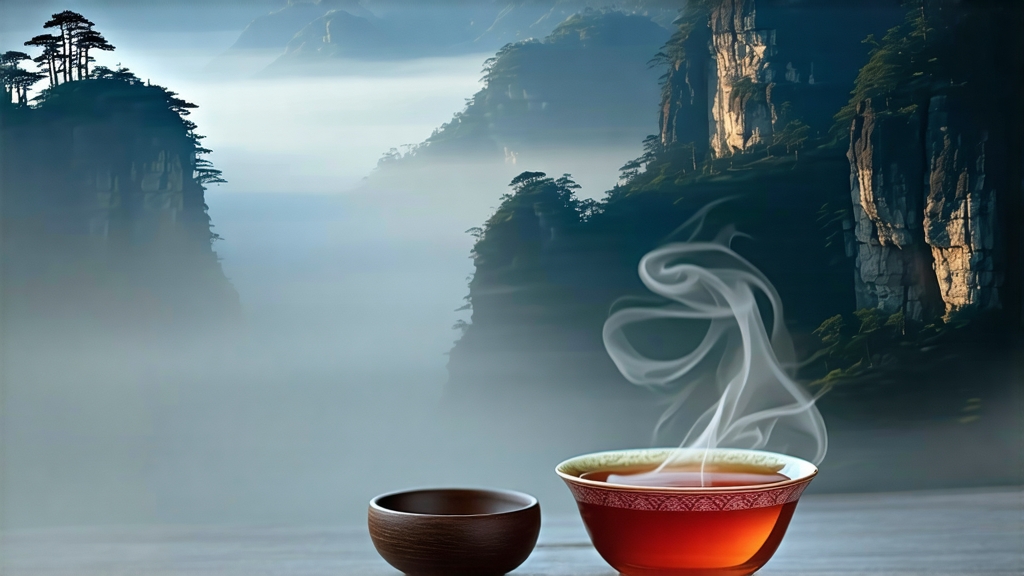
Long before Assam, Ceylon or Earl Grey ever existed, the first fully oxidised leaf that Europe would later call “black tea” was born in the rugged Wuyi Mountains of northern Fujian. Locals named it Zheng Shan Xiao Zhong—“small leaf from the original mountain”—but the trading posts of Xiamen labelled it Lapsang Souchong, and under that exotic title it sailed out of Canton in the early 1600s, filling the holds of Dutch galleons and, soon after, the porcelain cups of Stuart London. Samuel Pepys wrote in 1660 that he sent for “a cup of tee, a China drink,” almost certainly bohea of the Lapsang style; Catherine of Braganza made it fashionable at court; and by the eighteenth century the East India Company was paying for entire harvests with chests of silver. In other words, every modern black tea dynasty traces its lineage back to this smoke-wreathed leaf.
Geography is the first secret. The core “zhengyan” zone lies inside Tongmu Guan, a protected ravine where the Min River cuts through granite cliffs shrouded in subtropical mist. Day-night temperature swings of 15 °C slow the growth of the tea bush, concentrating amino acids and volatile aromatics. The forest is dominated by Masson pine and cedar; their resinous heartwood will later become the fuel that gives Lapsang its signature perfume. Only five small villages—Tongmu, Guadun, Miaowan, Guangping and Tongzhou—are recognised under China’s National Geographic Indication, and every kilo of authentic leaf is picked within this 600 m to 1200 m microclimate.
The cultivar itself is a group of sexually propagated “cai cha” seedlings rather than a single cloned variety. Their leaves are noticeably smaller and thicker than those of the Fuding Da Bai used for white tea, with a deep olive hue and a downy reverse that catches the mountain light. Because the plants are seed-grown, each bush expresses subtle genetic drift; master blenders prize this biodiversity, claiming it creates the layered complexity that single-clone gardens lack.
Craft begins in the cool dawn of late April or early May, when two leaves and a bud are plucked by nimble fingers that have learned to twist rather than snap the stem. The harvest must reach the village workshop within two hours; any longer and enzymatic browning will race ahead of the withering schedule. Inside thick-walled wooden longhouses, the leaf is spread on bamboo screens raised two metres above smouldering pine logs. The fire is never allowed to flame; instead it exhales a cool, aromatic smoke that drifts through the rafters like incense. For the first eight hours the tea is only scented, not heated—the goal is to reduce moisture from 78 % to 65 % while impregnating the leaf with pinewood terpenes. Once the green bite has left the leaf, workers roll it gently on rattan mats, breaking cell walls and releasing catechins that will oxidise into theaflavins and thearubigins. The rolled leaf is then piled in cedar-lined boxes, covered with wet cloths, and left to ferment for three to five hours. Oxidation here is arrested not by baking but by a second, hotter smoking phase: the same pine logs now burn at 80 °C, and the leaf is dried for thirty minutes while absorbing a final kiss of smoke. The result is a glossy, jet-black strip that crackles when flexed and exudes a scent of pine resin, longan and dried lychee.
Traditional Lapsang is only lightly smoked; the harsh, tarry flavour that many foreigners associate with the name comes from later export grades that were rushed over high fires for the Russian caravan trade. The authentic Tongmu style, increasingly available from specialty importers, is subtle: the smoke hovers like a memory behind notes of honeyed fig, roasted sweet potato and the cooling camphor note that Wuyi locals call “yan yun” or cliff rhyme.
To brew it Western-style, use 2.5 g of leaf (about a heaped teaspoon) for 250 ml of freshly drawn water at 95 °C. Steep three minutes in a pre-warmed ceramic pot. The liquor glows amber-rose, almost the colour of a young Barolo. Sip without milk: the first impression is a whisper of